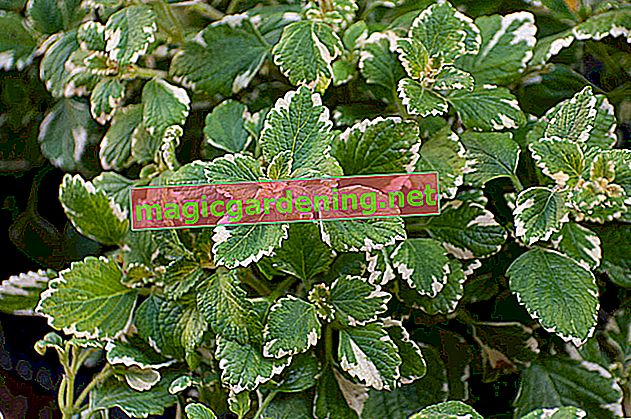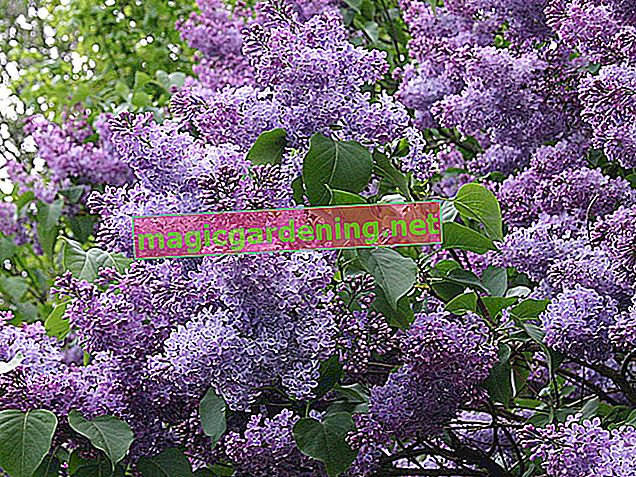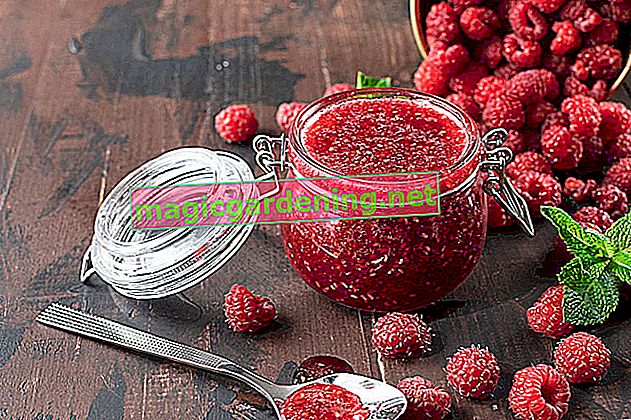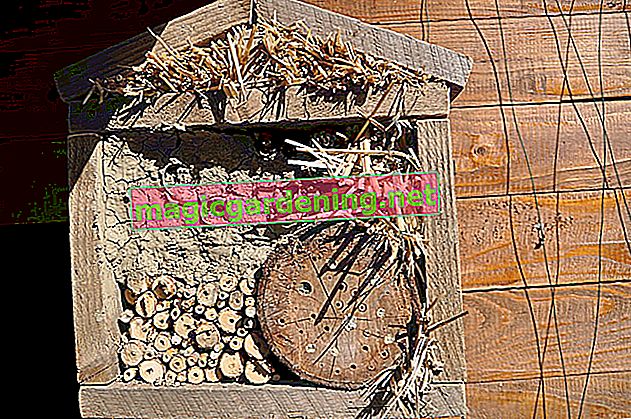
origin
The frankincense plant belongs to the large genus of the harp bushes, botanically Plectranthus, within the mint family. This genus comprises an impressive number of more than 350 species, some of which differ from one another in terms of growth and habit.
also read
- Propagating Frankincense Plant - How to Grow New Plants
- Cultivate the frankincense plant on the balcony
- The frankincense plant is not poisonous
Harp bushes mainly come from tropical to subtropical areas of Africa and the Far East, some species are also native to parts of Australia and New Zealand as well as the Middle East. Depending on the species, they colonize quite different habitats from warm, humid forests to cooler, maritime climates such as the South African Cape region. Most of the Plectranthus species here are not winter hardy.
Basically only the cultivars of the two common species Plectranthus glabratus and Pectranthus forsteri are referred to as frankincense. P. coleoides is also one of them, but is rarely found in its pure form. The species P. glabratus comes from the tropical Far Southeast, from parts of India, Thailand, Sri Lanka and Vietnam, the species P. forsteri, on the other hand, is native to the southwestern Pacific Islands (Fiji, Vanuatu).
The common collective name 'frankincense plant' can be attributed to the aromatic, ethereal fragrance that these species give off. It is reminiscent of that of the real frankincense tree (botanically Boswellia carterii), to which the frankincense plant is not remotely related. Nevertheless, frankincense plants with their fragrance character have a very high value for the sensory design of the balcony and terrace. They are also supposed to drive away moths and mosquitoes. However, not only the frankincense plants, but also most of the other Plectranthus species have a very intense and ethereal scent; some are also used as aromatic plants.
Origin at a glance:
- Plectranthus species are generally found in large parts of tropical to subtropical areas in Africa, the Far East and Australia
- Only the cultivars of the species P. glabratus and P. forsteri are referred to as 'frankincense plants'; these come from tropical Southeast Asia and the southwestern Pacific islands
- No botanical relationship with real frankincense tree, just a similarly spicy, ethereal fragrance
growth
Plectranthus species usually grow as perennials, some are only annual or form a semi-shrubby habit. There are also succulent varieties. The upright to overhanging stems form long shoots and are hairy.
The frankincense plants in particular develop a more pendulous than upright habit - they only grow to a height of 20 to 30 cm, but develop very long hanging gears that take up a lot of space. This must be taken into account when it comes to balcony culture. Frankincense plants also grow very quickly.
Growth characteristics in brief:
- Plectranthus species mostly perennials, rarely annual, sometimes semi-shrubby
- Hairy, upright to drooping stems
- Frankincense plants show a clearly hanging habit with a height of 20 - 30 cm and long shoots
- Rapid growth
leaves
From an ornamental horticultural point of view, the leaves are the main thing in frankincense plants. With their shape and color, they have a lot more to offer aesthetically than the inconspicuous flowers - incense plants therefore clearly belong to the decorative foliage plants in our local garden culture.
As with most Plectranthus species, the leaves of frankincense plants are opposite to the richly branched stems. They are short stalked and have an egg-shaped contour with softly notched leaf margins. Characteristic of the varieties sold in specialist shops is the pretty variegation, which is usually shown in a fresh green center and irregular edges in creamy white. The essential oils contained in the leaves are of course responsible for the incense-like fragrance, which is particularly intense when touched.
Blade properties in brief:
- Leaves on frankincense plants are the main decoration
- Set against each other
- Short stalked, ovate, notched leaf margins
- Nice variegation in cultivars
- Essential oils give off a spicy scent
blossom
As I said: the flowers play a secondary role in frankincense plants. These are small, inconspicuous, paniculate inflorescences in a whitish tone that appear between May and August.
Which location is suitable?
Frankincense plants need a sunny, warm location, but they can also do in partially shaded places. In any case, you should ensure a few hours of sunshine if you value vital, compact growth and a beautiful development of the leaf variegation. In partial shade, the plant can become a bit sparse and lack of leaves. Because of their lush overhanging growth with long shoots, cultivation in the hanging basket is very advisable. This not only gives the plant enough space at the bottom, but also shows its best advantage with its hanging habit.
The frankincense plant can also be kept in the room all year round. You should give her a bright window seat there. With a pleasant living temperature of 18 to 20 ° C, it gets along well.
To note:
- As sunny, warm location as possible, but partial shade also possible
- Growth and variegation are best when there is plenty of light
- Ideal in hanging baskets
balcony
A frankincense plant on the balcony makes it very beautiful, where it can enhance the rather narrow seats not only with its very pretty leaves, but also with its scent that flows out intensely when touched. In addition, a balcony often offers good conditions for an incense plant due to its close-to-home and protected character. It is best, of course, if it faces south. In the case of balconies in residential complexes, the next-higher neighboring balcony can also be used to hang up a planting light.
Continue reading
What soil does the plant need?
When it comes to substrate, frankincense plants are not very picky. It should only be reasonably nutritious and permeable. You can best use a universal potting soil and add some deciduous compost to it. In this way you can permanently supply your frankincense plant with good, organic fertilizer. Loosen the soil with a little sand to ensure good water drainage. A certain mineral content also helps to store water.
Water the frankincense plant
Frankincense plants are relatively thirsty and require constant attention, especially in summer and when they are standing / hanging in the sun. If the weather is very warm and sunny, you will be asked to go to the watering can at least once a day. Make sure that the soil always remains moist, but avoid waterlogging. In addition, it is also good for the tropical plant to get a refreshing shower from the water dispenser every now and then. This is especially recommended if you keep them in the room all year round. It is best to use soft, lukewarm water. The frankincense plant is also suitable for hydroponics.
To note:
- Water quite a lot, especially on hot summer days
- But avoid waterlogging
- In addition, occasional overspray
- Use soft, lukewarm water
Fertilize the frankincense plant properly
During the main vegetation phase, from May to August, you can provide the frankincense plant with some liquid fertilizer for balcony or green plants about every 14 days. There is no fertilization in winter. You should only fertilize a freshly bought or repotted specimen after about 6 weeks at the earliest.
Hardy
Like most Plectranthus species, the frankincense plants from the tropical warm areas of Far Asia are naturally not prepared for our Central European winters. Long-term outdoor cultivation is therefore not possible.
Continue reading
Overwinter
If you keep a frankincense plant outside in summer, because of its sensitivity to cold you will have to bring it indoors in autumn as soon as the first frosts appear. Although she is not used to the seasons from her home country, you should adjust the ambient conditions a little in winter - after all, deprivation of light cannot be avoided. The corresponding pause in vegetation must also be accompanied by a slightly lower ambient temperature and less watering. In the winter quarters, the temperature should be around 12 to 16 ° C. You reduce watering to a minimum - just enough so that the root ball does not dry out completely.
From March, when the amount of light increases noticeably, start watering more intensively and can also start with the first fertilizers.
Continue reading
Cut the frankincense plant correctly
Actually, incense plants do not need pruning - if they are sunny and warm, they develop a beautiful, compact growth and if they are kept in the planting lamp, the long hanging sprouts make their typical character. Nevertheless, they can of course be too long for one or the other. In that case, they can easily be shortened. You should also clean out any bald or dried-up shoots, if they appear at all.
Use the sharpest possible cutting tools for cutting measures so as not to squeeze the somewhat sensitive stems and do not cut into the lignified lower areas.
Propagate the frankincense plant
Frankincense plants are best propagated using cuttings. To do this, cut cuttings about 7 cm long from healthy shoots in spring, preferably directly under a leaf base. Remove the leaves in the lower area and put the cuttings prepared in this way in a planter with potting soil. Place it in a bright, warm place - the ambient temperature should be around 20 ° C. Keep the soil evenly moist, the cuttings have good growth chances in an evenly warm, humid microclimate under a film or in a mini greenhouse. (€ 6.96 at Amazon *) As soon as the cutting has new shoots, you can place it in a larger planter with more nutrient-rich soil.
Continue reading
Is frankincense poisonous?
The frankincense plant is not poisonous. Even if the varieties of Plectranthus glabratus and forsteri are not suitable as aromatic plants, they are not dangerous for curious small children or pets.
Continue reading
sorts
In specialist shops you will find many cross breeds, especially of the varieties Plectranthus glabratus and forsteri. These differ a little mainly in the color of the leaves.
The best known and best-selling is probably the variety Plectranthus forsteri 'Marginatus'. It shows itself attractively multicolored with the typical creamy white border around a fresh green leaf heart.
The variety P. f. 'Aureus Variegatus' has slightly yellowish green leaves and is characterized by long, beautifully hanging shoots.
The P. f variety is also relatively popular. 'Nico'. Its leaves have no variegation, but are no less attractive with their fine-edged, pointed contour and the combination of dark green top and purple bottom.








